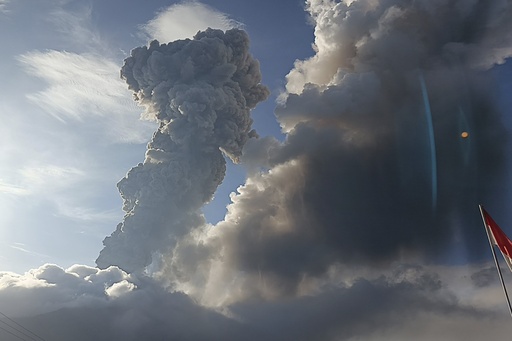MAUMERE, Indonesia — The Mount Lewotobi Laki Laki volcano in Indonesia has been actively erupting, releasing impressive columns of hot ash into the atmosphere following a significant eruption that resulted in the deaths of nine individuals and injuries to numerous others.
Since the initial eruption on Monday, the activity at this remote volcano located in Flores within the East Nusa Tenggara region has intensified, prompting authorities to widen the danger zone as of Thursday. According to Hadi Wijaya, the head of the Center for Volcanology and Geological Disaster Mitigation, the most recent eruption has generated an ash column reaching heights of 10 kilometers (6.2 miles).
Wijaya mentioned that volcanic debris, including glowing rocks, lava, as well as sizable ash fragments, have been ejected as far as 8 kilometers from the volcano’s crater. Fortunately, no casualties were reported in the latest outburst. The volcano monitoring agency has elevated the alert level for Lewotobi Laki Laki to its highest status in response to the ongoing volcanic activity.
On Thursday, the authorities increased the danger zone to cover an 8-kilometer radius on both the northwest and southwest slopes of the volcano due to hot ash clouds dispersing in various directions. “We are still assessing the extent to which the danger zone radius should be further adjusted,” Wijaya added.
The ongoing eruptions have inflicted damage on educational institutions, thousands of residential properties, and various structures, such as churches and convents on this predominantly Catholic island. Experts on location have reported the existence of craters created by falling rocks, measuring up to 13 meters (43 feet) in diameter and 5 meters deep.
Authorities have cautioned the thousands of residents who evacuated the vicinity not to return to their homes, as plans are in place to assist approximately 16,000 individuals in relocating away from the hazard zone. The series of eruptions witnessed this week has already impacted over 10,000 people across ten villages, with more than half of them seeking temporary refuge in makeshift shelters.
In total, 2,384 dwellings and public facilities suffered damage or destruction, as tons of volcanic debris hit various structures, collapsing a primary road linking East Flores district with Larantuka district. Kanesius Didimus, the head of a local disaster management agency, reported this information. Relief efforts, including searches by rescue workers, police, and military personnel, are ongoing in devastated areas to ensure that all residents are evacuated from the danger zone. Concurrently, logistical aid and supplies are being provided to nearly 6,000 evacuees in three separate shelters.
The National Disaster Management Agency has indicated that residents in the most significantly affected villages would be relocated within the next six months. Each family awaiting reassignment will receive monthly compensation of 500,000 rupiah ($32). Earlier in January, about 6,500 individuals were evacuated due to initial eruptions, yanking thick ash clouds and leading to the closure of the Fransiskus Xaverius Seda Airport. Fortunately, that episode did not result in injuries or significant damage, yet the airport remains shut down due to continued seismic activity.
Three additional airports in the neighboring districts of Ende, Larantuka, and Bajawa were also closed starting Monday as Indonesia’s Air Navigation issued a safety warning regarding volcanic ash. Lewotobi Laki Laki, rising 1,584 meters (5,197 feet), is a part of a pair of stratovolcanoes in East Flores district, referred to locally as the husband-and-wife mountains, with “Laki laki” meaning male and “Lewotobi Perempuan” meaning female.
The volcano is among the 120 active ones within Indonesia, an archipelago home to 280 million people. Due to its location along the “Ring of Fire,” a dramatic belt of seismic fault lines encircling the Pacific Ocean, the country is vulnerable to earthquakes, landslides, and volcanic eruptions.
